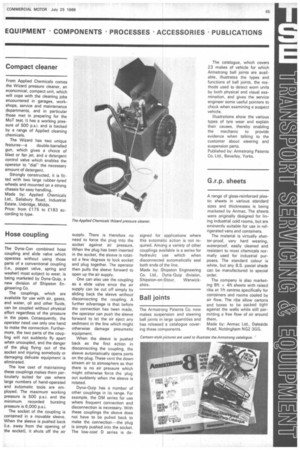Hose coupling
Page 67

If you've noticed an error in this article please click here to report it so we can fix it.
The Dyna-Con combined hose coupling and slide valve which operates without using those parts of a conventional coupling (i.e., poppet valve, spring and washer) most subject to wear, is being marketed by Dyna-Quip, a new division of Shipston Engineering Co.
The couplings, which are available for use with air, gases, and water, oil and other fluids, can be coupled without physical effort regardless of the pressure in the pipes. Consequently, the operator need use only one hand to make the connection. Furthermore, the two parts of the coupling will not suddenly fly apart when uncoupled, and the danger of the plug flying out of the socket and injuring somebody or damaging delicate equipment is eliminated.
The low cost of maintaining these couplings makes them particularly suited for use where large numbers of hand-operated and automatic tools are employed. The maximum working pressure is 500 psi. and the minimum recorded bursting pressure is 6,000 psi.
The socket of the coupling is contained in a movable sleeve. When the sleeve is pushed back (i.e. away from the opening of the socket), it shuts off the air supply. There is therefore no need to force the plug into the socket against air pressure. When the plug has been inserted in the socket, the sleeve is rotated a few degrees to lock socket and plug together. The operator then pulls the sleeve forward to open up the air supply.
One can also use the coupling as a slide valve since the air supply can be cut off simply by sliding back the sleeve without disconnecting the coupling. A further advantage is that before the connection has been made, the operator can push the sleeve forward to let the air eject any sediment in the line which might otherwise damage pneumatic equipment.
When the sleeve is pushed back as the first action in disconnecting the coupling, the sleeve automatically opens ports on the plug. These vent the down stream air to atmosphere so that there is no air pressure which might otherwise force the plug out suddenly when the sleeve is rotated.
Dyna-Quip has a number of other couplings in its range. For example, the DM series for use where frequent connection and disconnection is necessary. With these couplings the sleeve does not have to be pulled back to make the connection—the plug iS simply pushed into the socket. The low-cost P series is de signed for applications where this automatic action is not required. Among a variety of other couplings available is a series for hydraulic use which when disconnected automatically seal both ends of the line.
Made by: Shipston Engineering Co. Ltd., Dyne -Quip division,
Shipston-on-Stour, Warwickshire.
















































































































